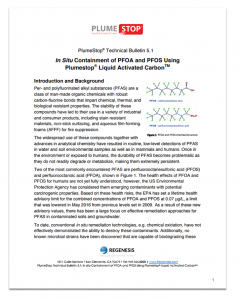To date, conventional in situ remediation technologies, e.g. chemical oxidation, have not effectively demonstrated the ability to destroy Per- and polyfluorinated alkyl substances (PFAS) contaminants. Additionally, no known microbial strains have been discovered that are capable of biodegrading these substances. The currently accepted method of treatment for PFAS is through an ex situ pump-and-treat system equipped with activated carbon filters. While generally effective, this process can be complicated and expensive due to the large and dilute nature of many PFAS plumes, which are often difficult to treat completely.
In this technical bulletin, the REGENESIS Research and Development Department conducts a study of individual adsorption isotherms for PFOA and PFOS, which were measured in the REGENESIS laboratory, and interpreted them through a through a fate and transport model where the capture longevity of a PlumeStop barrier treatment can be estimated.
The results of this study indicate that PlumeStop is capable of physically removing PFOA and PFOS from the aqueous phase in order to provide an in situ approach for PFAS plumes. The ability to inject and distribute a sorbent within the aquifer allows for improved plume containment over pump and treat systems, with the potential to decrease the operating costs of ex situ treatment options. Additionally, future advances in destruction technologies could be applied at a later date in the area of the existing PlumeStop barrier to destroy the contaminants. Please access the Tech Bulletin by clicking the link below.


 Americas
Americas Europe
Europe Français
Français Deutsch
Deutsch Italiano
Italiano Español
Español



